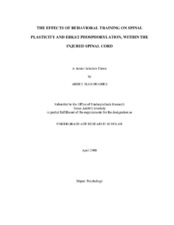| dc.description.abstract | Previous research has shown that even when communication between the brain and
spinal cord has been eliminated, rats can learn a simple instrumental response. If rats
receive shock to one hindlimb when it is extended (controllable shock), subjects will
learn to maintain that leg in a flexed position to minimize shock exposure. Conversely,
if shock is delivered irrespective of leg position (uncontrollable shock), subjects are
unable to maintain the same response and exhibit a learning deficit when later tested
with controllable shock. Recent studies have demonstrated that the adaptive
modifications accompanying learning and the maladaptive consequences of
uncontrollable nociceptive stimulation interact to influence behavioral outcomes. We
have shown that the induction of inflammatory processes increases responding to
noxious stimuli and undermines the capacity to learn. Behavioral training with
controllable shock, on the other hand, protects against these effects, allowing subjects to
learn. At the cellular level, the presentation of noxious stimuli increases nuclear
iv
localization of phosphorylated (activated) extracellular signal-regulated kinases 1 and 2
(ERK1/2). Here, we explore the impact of instrumental training and inflammation on
cytosolic ERK1/2 activation. Subjects received 30 min of instrumental training or
subcutaneous hindpaw injections of 1% capsaicin (50 μL vol). The lumbar region of the
spinal cord (L4-S2) was then collected 0, 3, and 24 hr later, and prepared for western
immunoblot analysis. A group of untreated rats were included as controls. We found a
time-dependent effect on cytosolic ERK1/2 phosphorylation, with the greatest levels
observed 24 hr following treatment. We also found that instrumental training or
capsaicin treatment downregulated cytosolic expression of phospho-ERK1 and phospho-
ERK2. Taken together, these results suggest that instrumental training and inflammation
engage similar signaling pathways. Further work will be integral for determining how
the cellular consequences of instrumental training and inflammation interact to produce
divergent behavioral outcomes. | en |


